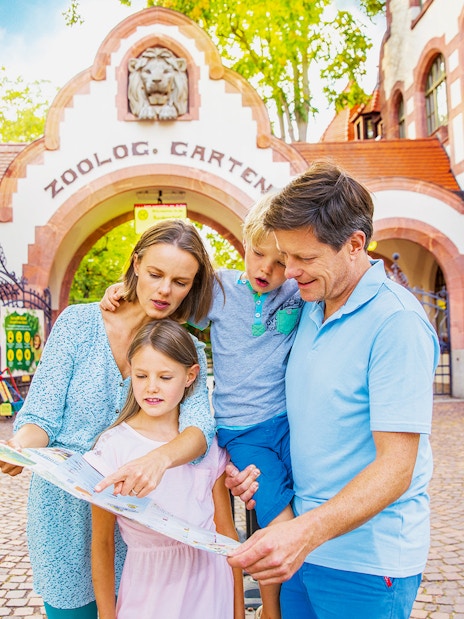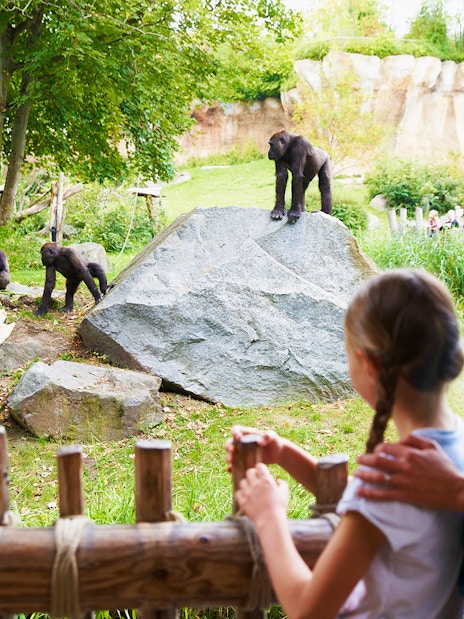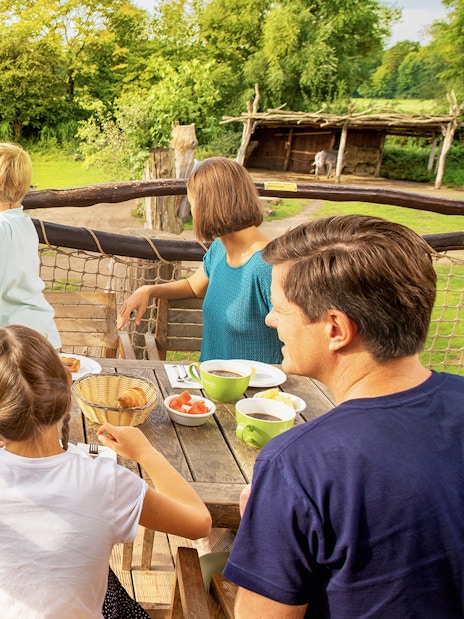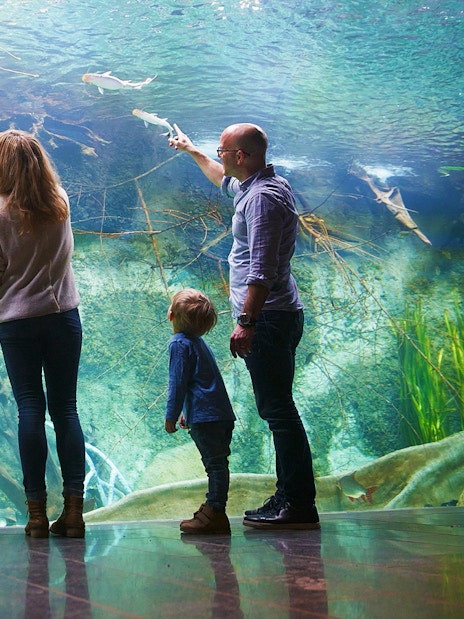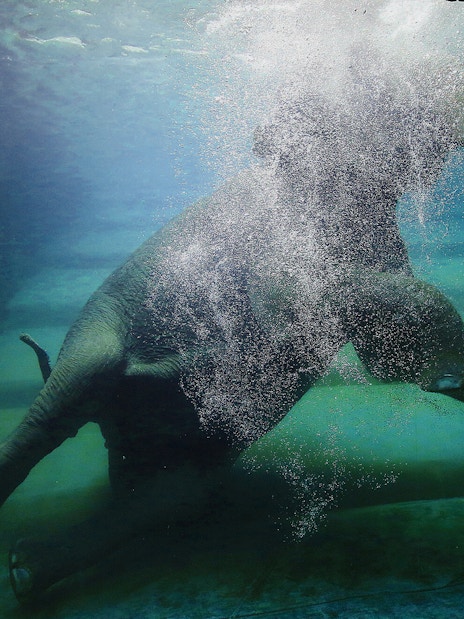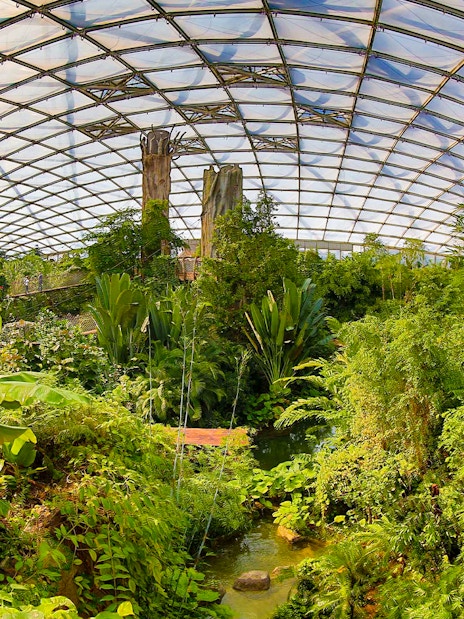Leipzig Zoo tickets
Headout is an authorized and trusted partner of the venue, offering curated experiences to enjoy this attraction. This is not the venue's website.

- Explore six theme worlds of Zoo Leipzig and learn more about the importance of the conservation of natural habitats and endangered species.
- Immerse yourself in the native environments of Africa, South America, Asia, etc., and get to know their 850 resident species, including those that are critically endangered.
- In Gondwanaland, let your senses immerse in the vibrant rainforest of Africa, Asia, and South America as you boat down the exotic jungle river.
- Climb up to the observation deck and take in a breathtaking 360-degree view of Gondwanaland, Europe's most expansive tropical adventure hall.
- Catch a glimpse of the majestic herd of elephants in Asia as they take their daily plunge.
- Catch a glimpse of the chimpanzees, bonobos, gorillas, and orangutans at Pongoland the one of its kind ape enclosure.
- Explore six theme worlds of Zoo Leipzig and learn more about the importance of the conservation of natural habitats and endangered species.
- Immerse yourself in the native environments of Africa, South America, Asia, etc., and get to know their 850 resident species, including those that are critically endangered.
- In Gondwanaland, let your senses immerse in the vibrant rainforest of Africa, Asia, and South America as you boat down the exotic jungle river.
- Climb up to the observation deck and take in a breathtaking 360-degree view of Gondwanaland, Europe's most expansive tropical adventure hall.
- Catch a glimpse of the majestic herd of elephants in Asia as they take their daily plunge.
- Catch a glimpse of the chimpanzees, bonobos, gorillas, and orangutans at Pongoland the one of its kind ape enclosure.
Inclusions
- Admission to Leipzig Zoo
- Access to the founder's house
- Access to Pongoland
- Access to Gondwanaland
- Access to Adventure World Africa
- Access to Adventure World South America
- Access to Adventure World Asia
- Tip: You may time your visit to the zoo with one of the many events and activities they host all year long, such as a bird display or an informative lecture.
- Facilities: Parking lot, wheelchair accessibility, stroller accessibility.
- You can rent strollers and baby carriages from the zookeepers at the entrance for a small rental fee.
- Supervised zoo tours are available for people with disabilities.
- The boat tour is also suitable for wheelchair users.
- Please Note: Free entry for kids under 6 years.
- These tickets can't be cancelled or rescheduled.
Why visit Leipzig Zoo?

- Up close with nature: Leipzig Zoo offers an incredible experience where you can explore naturalistic habitats like the Gondwanaland rainforest, the Pongoland ape sanctuary, and the African savanna. Each zone is meticulously designed to replicate the animals' natural environments.
- Diverse wildlife: Leipzig Zoo boasts a remarkable array of animals from every corner of the globe. From majestic lions and playful penguins to rare reptiles and exotic birds, the zoo's biodiversity is truly astounding.
- Interactive activities: With interactive exhibits, educational programs, and daily animal feeding and shows, the zoo has a variety of family-friendly activities that make learning about animals fun and exciting for all ages.
- Conservation efforts: The zoo actively participates in many species and nature conservation projects in Germany and around the world. You can learn about these initiatives at the zoo's state-of-the-art education center, the Ark Discovery House.
- Beautiful landscapes and relaxation: Leipzig Zoo is also a haven for nature lovers. It features beautifully landscaped gardens with vibrant flowerbeds, lush greenery, and serene water features that create a picturesque environment. As you stroll through the grounds, you'll find peaceful spots like shaded benches and secluded pathways where you can pause, take in the scenery, and simply unwind.
Zones at Zoo Leipzig

Founder's House
The Founder's House showcases Ernst Pinkert's vision, who established the zoo in 1878. This area comprises an ensemble of buildings, including the Explorers' House Ark, the Koala House, and the Aquarium with its adjacent Terrarium. Here, you can marvel at koalas, golden lion tamarins, coppery titi monkeys, and a variety of fishes and birds.

Pongoland
Pongoland is a unique global ape habitat. It's home to chimpanzees, bonobos, gorillas, and orangutans. This new and roomy outdoor space for apes opened in 2001. It also has a study center with the Max Planck Institute for Evolutionary Anthropology, where visitors can observe these intelligent creatures up close.

Gondwanaland
Gondwanaland mimics tropical rainforests from Africa, Asia, and South America. This zone is home to nearly 170 species, including the rare Eastern Quoll, the elusive Ocelot, and the mighty Komodo Dragon. You can explore the canopy from suspension bridges, wander through dense vegetation, or take a serene boat ride.

Africa
This zone replicates the vast savannas and diverse ecosystems of the African continent, offering a safari experience. Big cats, spotted hyenas, Patas monkeys, Grevy's zebras, Baringo giraffes, and Eastern Black rhinos reside here. The zone also houses the rare okapis, a species of forest giraffe, that has the head of a giraffe, the body of a horse, and the stripes of a zebra.

South America
In the South America zone, you'll encounter landscapes resembling Pantanal, Pampas, and Patagonia, featuring giant anteaters, maned wolves, guanacos, lesser rheas, and the rare Chacoan peccaries. The lagoon in this zone is home to over 120 flamingos, ibises, spoonbills, and ducks.

Asia
Enter the Asia zone to encounter a tapestry of habitats, from the rugged Himalayan slopes housing snow leopards to the lush jungles where sloth bears and red pandas thrive. Steppe landscapes house Przewalski horses, while Amur Tigers prowl wooded landscapes reminiscent of their natural habitat.
What to see at Zoo Leipzig?

Savannahs and large mammals
- Kiwara Savannah: Spot Rothschild giraffes, Grevy's zebras, ostriches, and more in a 25,000-square-meter habitat.
- Lion Savannah Makasi Simba: Observe lions and meerkats, and listen for the laughter of spotted hyenas.
- Ganesha Mandir: Marvel at Asian elephants in one of Europe's most modern enclosures.

Primates and playful bears
- Monkey Isles: Meet golden lion tamarins, coppery titi monkeys, and bearded emperor tamarins in a lush green setting.
- Koala House: Experience a slice of Australia with solitary koalas in a naturalistic eucalyptus forest.
- Sloth Bears Ravine: Watch playful sloth bears in an interactive ravine habitat.

Birds and aviaries
- Australian Birds: Wander through the lively aviary of budgerigars, opposite the Koala House in the Founder's House.
- Asian Aviary: Immerse yourself in the calls of Black-crowned night herons, Glossy ibises, and Black-headed ibises.
- The Flamingo Lagoon: Enjoy a vibrant habitat with flamingos, spoonbills, ibises, and ducks in a South American setting.

Aquatic and tropical experiences
- Underwater Worlds: Explore vibrant saltwater pools and a 360˚ panorama tank with hammerhead sharks and cow nose rays.
- Luscious Flora: Wander through Gondwanaland, a rainforest with over 24,000 plants and exotic fruits.

Big cats and exotic wildlife
- Tiger Taiga: Encounter Amur tigers and explore Leopard Valley to see Amur leopards in a rocky terrain.
- The Himalayas: Discover snow leopards, Michie's tufted deer, and red pandas in a mountainous environment.
Plan your visit to Leipzig Zoo

1st January - 20th March: 9am - 5pm
21st March - 30th April: 9am - 6pm
1st May - 30th September: 9am - 7pm
1st October - 30th October: 9am - 6pm
31st October (Halloween): 9am - 8pm
1st November - 30th December: 9am - 5pm
- 24th December (Christmas Eve): 9am - 3pm
- 31st December (New Year's Eve): 9am - 3pm
Best time to visit: Visit during zookeeper talks and feeding times in the late morning and early afternoon. For fewer crowds, go on a midweek visit outside the peak summer season and school holidays.
Leipzig Zoo opening hoursAddress: Leipzig Zoo, Pfaffendorfer Str. 29, 04105 Leipzig, Germany
Find on Maps.
- By tram: Tram line 4 or 12
Nearest station: Zoo, Leipzig - By bus: Bus number N5
Nearest stop: Zoo, Leipzig - By car: The zoo is 19.5 km away from Leipzig Airport
Nearest car parking: The zoo has 1,300 parking spaces near the main entrance.

- There’s a no-queue ticket service at the safari office desk for visitors with disabilities.
- There are wide paths and ramps for wheelchairs, strollers, and buggies.
- You can rent a wheelchair at the zoo for a deposit.
- There are onsite restaurants equipped with disabled-accessible toilets.
- You’ll find accessible parking spaces in covered garages.
- The zoo also has gift shops selling souvenirs, including t-shirts, hats, and stuffed animals.
- There is a conference center with a 1,200-person capacity, suitable for meetings, conferences, and weddings.
- You’ll also find a playground equipped with climbing structures, slides, and swings for children.

- All international visitors must provide passport and visa details upon arrival.
- Feeding animals is strictly forbidden.
- No sharp objects, lighters, luggage bags, alcohol, or knives are allowed inside the zoo.
- Visitors must stay on designated paths and areas.
- Do not annoy or tease animals or bang on the windows of the animal enclosures.
- Do not trespass over barriers or allow your children to sit on enclosure fences.
- Throwing objects into water bodies and enclosures is strictly prohibited.
- Bringing animals into the zoological garden is not allowed.
- Photography and filming are allowed for private use, respecting the privacy rights of visitors and employees.
- Please do not drink or smoke within the zoo.

- Kiwara Lodge: Located in the African Savannah, it offers a self-service buffet of African specialties. Enjoy a fantastic view of giraffes, zebras, and oryx while dining.
- Palmensaal: This restaurant provides 300 seats with stylish palm decor. Features a terrace overlooking the concert garden, offering all-day dining in scenic surroundings.
- Bamboo Bar: Visit this eatery for light snacks and refreshments before embarking on a boat journey in Gondwanaland. It is located near the boat jetty on the village square.
- Restaurant Patakan: With 150 seats, it serves Far East cuisine amidst lush tropical views. Ideal for hungry explorers journeying through Gondwanaland.
- Bear Castle Café: Situated near a giant dragon, it offers terraced seating. Family Kandler provides a tasty selection of homemade pastries, ice cream, and BBQ sausages.
- Hacienda Las Casas: Explore the flavors of South America at Hacienda Las Casas, housed in a beautifully restored art nouveau building. Inside, it accommodates 120 guests, with an additional 40 seats on a covered terrace and an open terrace for over 300 people.

- Book your Leipzig Zoo tickets at least 2-3 weeks in advance to avoid waiting in lines.
- Pick up a zoo map at the entrance to easily navigate the zoo and ensure you don't miss any exhibits.
- If needed, you can borrow wheelchairs from the entrance.
- Check the schedule for animal feeding times and keeper talks, which provide interesting insights into the animals and their care.
- When taking photos at the zoo, remember not to use flash to avoid disturbing the animals. It's important to maintain a respectful distance and adhere to the zoo's guidelines for wildlife photography.
- Keep a watchful eye on young children to prevent them from wandering off or trying to interact with the animals.

- Naturkundemuseum: Leipzig's Natural History Museum gathers, studies, and preserves north-western Saxony's natural treasures in geology, botany, zoology, and archaeology. It is located 0.8 km from the Leipzig Zoo.
- St Thomas Church: St. Thomas Church is a famous Lutheran Church. It's where Johann Sebastian Bach worked and is buried. The church is home to Thomanerchor, a boy's choir from 1212. This historic site is just a short 2.2 km distance from Leipzig Zoo.
- Völkerschlachtdenkmal: The Battle of the Nations Monument (German:Völkerschlachtdenkmal) in Leipzig commemorates Napoleon's defeat in 1813. This historic monument is a key point in the War of the Sixth Coalition. It is located 6.2 km away from Zoo Leipzig.
Frequently asked questions about Leipzig Zoo tickets
The price of Leipzig Zoo tickets starts from . Children below the age of 6 can enter for free.
Yes, the zoo is wheelchair accessible with paved paths all around. A free wheelchair is also offered with a deposit.
Yes, Leipzig Zoo offers several daily feeding shows and keeper talks that provide fascinating insights into the lives of the animals. Witness the feeding shows of various animals, including koalas, penguins, lions, baboons, and hippos. Or learn from the experts during scheduled keeper talks that cover a range of topics, from animal behavior to conservation efforts. You can also interact with friendly domestic animals like goats, rabbits, and pot-bellied pigs in a dedicated petting area. It’s a delightful experience, especially for young children.
Absolutely! Leipzig Zoo is one of the top-rated attractions in the region. Home to over 850 species, including exotic animals from all over the world, the zoo offers an opportunity to see creatures you might never encounter otherwise.
To make the most of your zoo visit, head there early when it opens. This way, you can enjoy the exhibits before the crowds roll in. The spring and autumn seasons are ideal, thanks to the mild weather and lush, colorful landscapes. You might also catch some animals at their most active during these times.
For the safety and comfort of both the animals and visitors, pets are not allowed inside Leipzig Zoo. Only service animals are permitted.
Leipzig Zoo is heavily involved in wildlife conservation and participates in numerous breeding programs for endangered species. The zoo also supports global conservation projects and conducts research to promote animal welfare.
Yes, photography and filming for personal use are permitted throughout the zoo.

